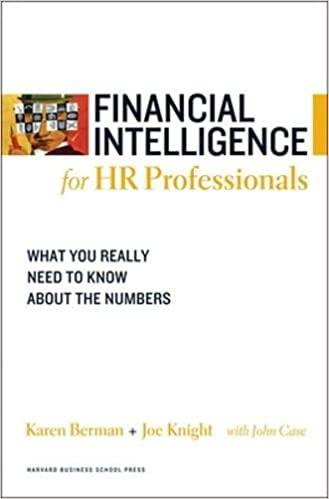Question
The company has been growing steadily over the past 5 years, and the financials and future prospects look good. Your CEO has asked you to
The company has been growing steadily over the past 5 years, and the financials and future prospects look good. Your CEO has asked you to run the numbers. After doing some digging into the business, you have gathered information on the following:
-
The estimated purchase price for the equipment required to move the operation in-house would be $750,000. Additional net working capital to support production (in the form of cash used in Inventory, AR net of AP) would be needed in the amount of $35,000 per year starting in year 0 and through all years of the project to support production as raw materials will be required in year o and all years to run the new equipment and produce components to replace those purchased from the vendor..
-
The current spending on this component (i.e. annual spend pool) is $1,200,000. The estimated cash flow savings of bringing the process in-house is 20% or annual savings of $240,000. This includes the additional labor and overhead costs required.
-
Finally, the equipment required is anticipated to have a somewhat short useful life, as a new wave of technology is on the horizon. Therefore, it is anticipated that the equipment will be sold after the end of the project (the last year of generated cash flow) for $50,000. (i.e. the terminal value).
As part of your research, you have sought input from a number of stakeholders. Each has raised important points to consider in your analysis and recommendation. Some of the points and assumptions are purely financial. Others touch on additional concerns and opportunities.
Question:
Olivia, the head of Operations, is concerned that instead of stabilizing the supply chain, it will just add another process to be managed, and will distract from the core competencies the company currently has. She f eels the company should focus on improving communication and supply chain management with its current vendor, and she feels confident he can negotiate a discount of 4% off of the annual outsourcing cost of $1,200,000 if she lets it be known they are considering taking over this step of the process. As there is little risk associated with Olivias proposal due to no upfront capital requirements, a lower risk-free discount rate of 7% would be appropriate. Oliva feels that any price reductions from the current vendor will last for five years. (NOTE: because there is no investment, the Payback and IRRmetricsarenotmeaningful. SimplyprovidetheNPVoftheSavingscashflows).
Using the data presented above (and ignoring the extraneous information), for this profit and supply chain improvement project, calculate each of the following (where applicable):
-
Nominal Payback
-
Discounted Payback
-
Net Present Value
-
Internal Rate of Return
Given,
Current outsourcing cost per year= $1,200,000 and expected reduction= 4%
Therefore, Amount of cost savings per year= 1200000*4% = $48,000
Also given,
Period of price reduction= 5 years
Discount rate= 7%
Net Present value of cost savings = 48000*(PVIFA 7%, 5)
=48000* 4.100197 = $196,809.48
Step by Step Solution
There are 3 Steps involved in it
Step: 1

Get Instant Access to Expert-Tailored Solutions
See step-by-step solutions with expert insights and AI powered tools for academic success
Step: 2

Step: 3

Ace Your Homework with AI
Get the answers you need in no time with our AI-driven, step-by-step assistance
Get Started


